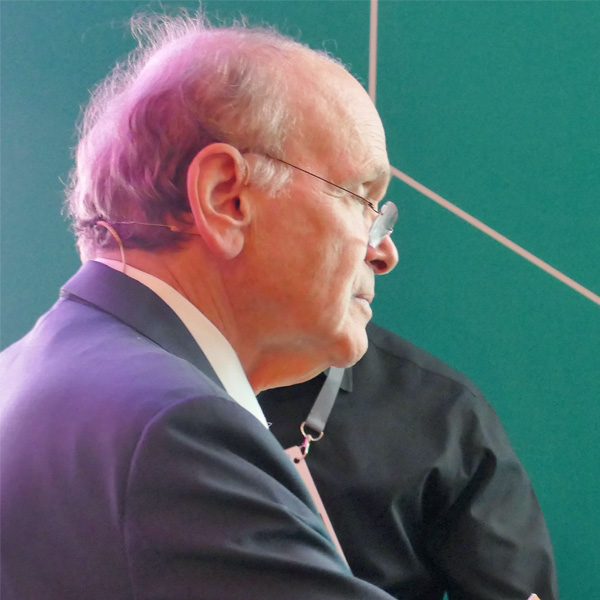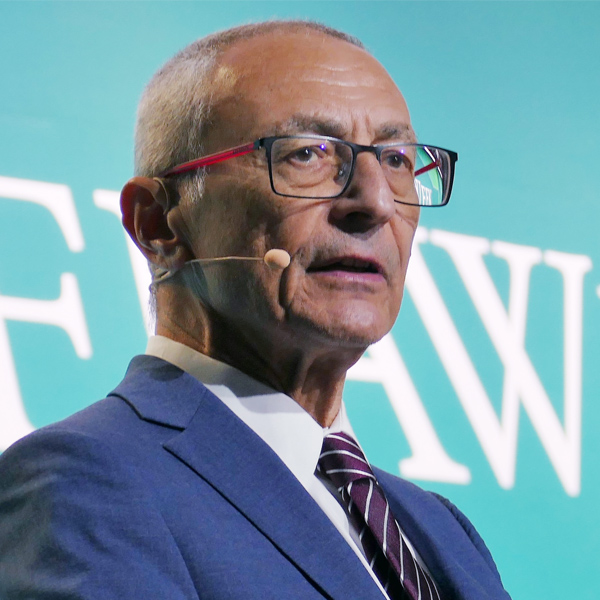HOUSTON — The energy transition and the march of new technology were key highlights of last week’s CERAWeek by S&P Global, which began 41 years ago with a focus on oil and gas.
The annual global energy conference attracted a record 7,200 executives, policy makers and others from 90 countries during what organizers called “the most innovative period in the history of energy.”
More than three dozen sessions were held on hydrogen energy alone. Members of the Biden administration were on hand to add context to the Inflation Reduction Act (IRA) and explain its incentives for all parts of the industry.
 CERAWeek by S&P Global co-founder Daniel Yergin | © RTO Insider LLC
CERAWeek by S&P Global co-founder Daniel Yergin | © RTO Insider LLC“The energy industry continues to grapple with the twin challenges of meeting the world’s growing energy demand while reducing emissions and redesigning the world’s energy systems for a lower carbon future,” CERAWeek chair and co-founder Daniel Yergin said in a post-conference message.
Among the more than 1,000 speakers was John Podesta, President Biden’s senior adviser for clean energy innovation and implementation and chair of the National Climate Task Force.
“It’s no secret that the energy industry is changing. In these halls experts are showcasing innovative energy technologies, clean hydrogen stations, sustainable aviation fuels, direct air capture,” Podesta said. “Just a few years ago, many of these technologies were considered no more than a pipe dream. There are many reasons for this shift — economics, energy security amongst them.”
Podesta highlighted the economics of the climate crisis, saying extreme weather disasters last year cost the nation $165 billion in damage. The year before, it was $155 billion.
“Instead of paying to adapt to a problem of our own making, we could be solving that problem. We’ll do that by producing clean energy,” he said. “And thanks to President Biden there’s never been a better time to invest in clean energy in America.”
Under the bipartisan IRA, the Department of Energy has made billions of dollars available for demonstration projects and energy technologies, Podesta said. He said the Commerce Department, under the Chips and Science Act, is overseeing another $50 billion in investments to the domestic semiconductor industry, which is critical to the battery and solar industries.
“We’re setting the rules of the road to grow the economy from the bottom up … that will make clean energy jobs, good paying union jobs,” Podesta said. “And then it’s all up to all of you to grab the baton and to run with it. You just have to walk around the [technology-focused] Agora [exhibit hall] to see what the possibilities might look like. Now you can grow your clean energy investments by taking advantage of these new laws and create good-paying jobs while you’re at it.”
Responding to a question about pushback from other countries over the U.S. government’s support of clean energy, Podesta said, “We want European industry to succeed, but nothing beats American leadership on climate, innovation, technological development. We’re proud of the accomplishment of this bill.”
Addressing Issues with China
Podesta and John Kerry, the administration’s special presidential envoy on climate, both addressed China’s role in the global energy industry during their separate conversations.
Podesta said the U.S. needs to ensure supply chains are secure and “in friendly hands” to avoid authoritarian regimes blackmailing the rest of the world.
“The only way to do that is to kind of disperse supply, secure supply, and do it with our friends and allies, and I think, quite frankly, they agree with that,” he said. “We want to try to find a path forward where, particularly on these supply chain questions, we have a collaborative relationship with our allies and partners. It’s just clear to say directly, that China has too much of a chokehold on critical minerals, on critical mineral processing, and clean technologies and solar machines. We let that go. That was a mistake. We need to get it back, and we’re seeing that happen.”
However, it was a comment by Podesta later last week at an American Council on Renewable Energy conference that set off a bit of political turmoil. (See Democrats Make the Case for Updating Permitting Laws at ACORE.)
While describing U.S. efforts to build domestic manufacturing for clean energy technologies, Podesta said Chinese companies will need to participate. He conceded that the government will need to balance China’s involvement with concerns over reliability and energy security.
 John Podesta addresses a luncheon audience during CERAWeek by S&P Global. | © RTO Insider LLC
John Podesta addresses a luncheon audience during CERAWeek by S&P Global. | © RTO Insider LLC“The Chinese are going to be big players. They have a big domestic market. They’re already the leaders in electric vehicles,” Podesta said. “We’re aware of that, but we can’t be beholden to only Chinese supply for these critical materials, when they have indicated that they’re perfectly prepared to use their economic power when it serves their interests in a strategic way.”
Sen. Joe Manchin (D-W.Va.), chairman of the Senate’s Energy and Natural Resources Committee and another CERAWeek participant, issued a statement in response.
“It is beyond irresponsible for someone speaking on behalf of the White House to not only condone but also advocate for sending American tax dollars to Chinese companies,” Manchin said. “We have a dire dependence problem, and comments like this make it clear that this administration doesn’t care about the energy security of this nation. I will do everything in my power to prevent this administration from welcoming China to take federal dollars with open arms.”
Kerry, a former secretary of state, senator and presidential candidate, pointed out that the U.S. and China are the world’s two largest economies and two largest emitters. He agreed that the relationship between the two superpowers is currently difficult, “certainly the most difficult we’ve seen, certainly in my lifetime,” but that China remains one of the largest investors in renewable energy.
Asked whether he sees a prospect for developing “something constructive,” Kerry responded, “I do. I absolutely do.”
“I’ve met with the Chinese many times over the last few years,” he said, pointing to joint agreements on accelerating the transition from coal and deforestation. (60% of the world’s illegal logging goes to China, Kerry said).
“You have these things that just get in the way in a very serious way,” Kerry said, listing a series of global issues. “I regret to say that in the last months, the intensity has ratcheted up. The Chinese helped us on a number of different, very sensitive issues. We cooperated on the Iran nuclear agreement; we cooperated on [the] Paris [climate treaty]. I do think we can surmount this, and we have to. The United States and China have to find a way to define the differences … so that we can avoid the roiling of the markets and begin to deal intelligently with the world’s greatest issues.”
Kerry Calls for One Direction
Former U.S. ambassador (Mexico and Ukraine) Carlos Pascual closed his discussion with Kerry by noting the latter had extended his commitment as envoy through the end of the year.
“I take that as a …” Pascual began.
“As a sign of insanity?” Kerry interjected.
“ … reflection of your passion and commitment, but also one of hope,” Pascual continued.
Kerry likened the challenges facing the industry to the Allies’ collaborative effort during World War II.
“There were certain things we needed to do to win the war,” he said, using as an example a Michigan automobile plant’s ability to produce a B-24 bomber every hour. The decisions were made at the top, Kerry said, but it was the “people at the mid-level of engagement who made their own decisions because they were given a responsibility to get something done” that made the difference.
“That’s what we need to do. Some of these things we need to be deploying faster, whether it’s solar panels or wind turbines, or whatever we need to organize ourselves,” he said. “If we can get people moving in the same direction, the same sense of purpose or with the same sense of urgency, I absolutely guarantee we can win this battle.
“But we can also lose it if we just continue business as usual and don’t do the organizing necessary and liberating the kind of ingenuity of those mid-level people.”
Panel: IRA to Accelerate Transition
Speaking on a panel debating how best to accelerate the transition to net zero in the U.S., Joseph Majkut, director of the Center for Strategic and International Studies’ energy security and climate change program, said the key is not to impose costs.
“We want to demonstrate that there are huge benefits that accompany energy transition for consumers who might be lowering prices, right?” he said. “We might be able to get costs down for workers for those in these new energy technologies. It’s manufacturing jobs to building a supply chain … by building, by demonstrating these benefits, you can build momentum behind energy transition, such that we can accelerate our efforts. Everybody in Washington if you kind of get them in a quiet enough room and away from a camera, they know that this is not going to help us meet our even near-term climate goals, definitely not our long-term climate goals. If we can demonstrate that energy transition will bring benefits, then the belief is that we can accelerate our efforts over time.”
Meghan Nutting, executive vice president of government and regulatory affairs for solar developer Sunnova, said the IRA’s investment in energy-transition technologies is the “most impactful” she’s seen in her 15 years in the industry.
“To say it’s a big deal is an understatement,” she said. “On the solar side, we have a 10-year runway for the 30% investment tax credit. That makes the investment tax credit even more valuable. We have $41 billion that will be invested in domestic manufacturing … so we don’t have to worry so much about trade conflicts and we can produce that capacity domestically and serve people locally.”
Majkut said that while the IRA is a substantial investment, it has “ruffled feathers in every cardinal direction.”
The IRA “carries with it a lot of attempts to capture those benefits here in the United States … and a focus on sort of an America-first climate policy,” he said. “The champions of this legislation have talked about jobs, jobs, jobs. They don’t as much talk about emissions, emissions, emissions, and that is going to provoke a competitive response not just from our allies, but from countries where we’re competing, like China.”




